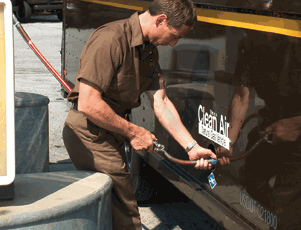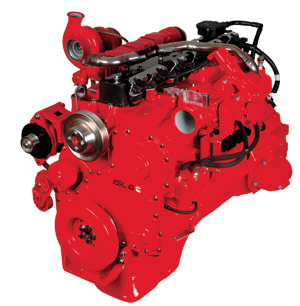For UPS, which moves nearly 16 million packages around the world each day, reducing fuel consumption and emissions is a constant priority. One of the company’s long stated goals is to minimize dependence on fossil fuels by improving operational efficiencies and advancing new technologies, including deploying alternative fuel vehicles.
The UPS alternative fuel fleet in the U.S. currently includes 11 liquefied natural gas (LNG) tractors in its West Coast operations. The vehicles travel each day fromCalifornia to Nevada. compressed natural gas (CNG) vehicles at UPS include more than 1,100 package delivery trucks. In January 2010, UPS eployed 245 new CNG vehicles in Colorado and California. The trucks are now in service in Denver and in San Ramon, Fresno, West Los Angeles and Ontario, Calif.
UPS began extensively using CNG in 1989. At the time, the company purchased gas- or diesel-powered vehicles and converted them to run on CNG. The 245 new trucks fielded recently were built from scratch as CNG vehicles.
“The greening of our fleet demonstrates the effectiveness of harnessing multiple technologies and applying the right vehicles to areas where they will provide the best advantage,” said Bob Stoffel, UPS senior vice president of supply chain, strategy, engineering and sustainability. “Compressed natural gas continues to be a sustainable technology for UPS’s fleet because natural gas is cost effective, clean-burning and abundant.”
CNG/LNG engine
CNG and LNG choices are available to fleets from several OEMs. At the heart of these offerings is the Cummins Westport ISL G engine that can be powered by either fuel. The ISL G was the first heavy-duty engine to meet EPA 2010 emission standards. The engine is designed with a new electronic control module that provides full monitoring and control of engine sensors, as well as fuel and ignition systems. 
The Cummins Westport ISL G is offered in five ratings: 250, 260, 280, 300 and 320 HP. Peak torque ranges from 730 to 1,000 lb./ft. The powerplant uses Cummins’ stoichiometric cooled exhaust gas recirculation (EGR). According to the manufacturer, the system’s high EGR rates in the combustion process in place of excess air improve fuel efficiency and create an oxygen-free exhaust.
That design, Cummins Westport also notes, allows for the use of a Three-Way Catalyst (TWC) for nitrogen oxide (NOx) emissions control. A TWC is a simple, maintenance-free device that reduces three harmful emissions: hydrocarbons (HC), carbon monoxide (CO), and nitrogen oxide (NOx). The end products are water (H2O), carbon dioxide (CO2), and nitrogen (N). The TWC is packaged as a replacement muffler. No further aftertreatment, such as a diesel particulate filter (DPF) or selective catalytic reduction (SCR), is required.
OEM choices
CNG or LNG fuel tanks can be configured to meet a variety of applications and range requirements.
Daimler Trucks North America offers the Cummins Westport ISL G in the Freightliner Business Class M2 112 truck in a total of six LNG and CNG tractor and truck configurations. By the end of this year, Freightliner expects to have a complete Cummins Westport-powered lineup with options for over 90% of truck applications in North America.
Kenworth Truck Co. offers the Cummins Westport ISL G in its T800 short hood and W900S models. The OEM also has T800 LNG trucks available with a Westport fuel system and GX 15-liter engine, which provides up to 450 HP and 1,650 lb./ft. of torque. The engine, which meets U.S. EPA and California Air Resources Board emissions standards, is based on the Cummins ISX 15-liter model.
Peterbilt Motors Co. offers the Cummins Westport ISL G in its Model 365 and Model 384 vehicles. The Model 365 NG is equipped with a 320 HP ISL G rated at 1,000 lb./ft. of torque.
Mack Trucks TerraPro Cabover and Low Entry refuse models are also available with the Cummins Westport engine. The alternative fuel technology, the OEM notes, combines all the advantages of clean-burning natural gas with the power and torque required by fleets. FE




